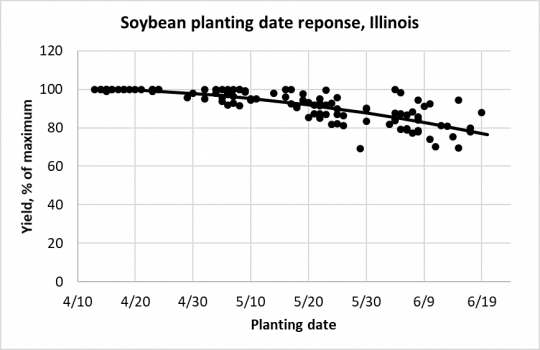To keep or not to keep that questionable soybean stand? Soybean growers are facing the tough decision on whether or not they will replant after what has been an extremely wet spring. Many publications state 80,000 plants per acre population will get you 100% of a “normal yield”, however it is important to take the increasing calendar date into consideration as well when looking at replanting or leaving the original stand. Nonetheless, we must go back to the basics of soybean replant before any decisions are made.
Step 1 – Identifying the Problem: Identifying the cause of the stand establishment issue is key because if conditions have not changed, replanting will not address the issue and could put the grower back in the same situation.
Step 2 – Determining Soybean Stand: The main objective of determining the viable soybean stand is to establish the population of the field. Iowa State University goes as far as stating that “narrow row widths exaggerate the impression of a low stand level because there are larger within-row spaces between plants” further stressing the point of the need to make stand counts.
There are two methods to estimate soybean stand: counting plants in a row which I will explain below and the hula hoop method. When using either method it is key to count only live plants and take a minimum of 5 random counts to determine the field average. Any soybean with a stem broken off below the cotyledonary node is considered dead and should not be counted. Plants with missing leaves can recover, but stem damage is more detrimental. Remember plants with bruised stems could have difficulty surviving.
To determine soybean population by counting plants in a row, count the number of plants in a length of row equal to 1/1,000th of an acre (See Table 1).
Table 1. Use this to determine how much row is equal to 1/1000th of an acre
| Row Width
(inches) |
Length of Row Needed to Represent 1/1000th of an acre |
|
30
|
17 feet, 5 inches |
|
20
|
26 feet, 2 inches |
|
15
|
34 feet, 10 inches |
|
10
|
52 feet, 3 inches |
|
7.5
|
69 feet, 7 inches |
Adapted from Purdue Extension publication ID-179, Corn & Soybean Field Guide
Step 3 – Looking at the Calendar: Research shows that planting dates before April 30th have a higher percentage for reaching maximum yield potential, so it is important to consider yield potential for a replant scenario. As the calendar date progresses after June 1st planting, replanting rates should increase a minimum of 10% to 15% to help with quicker row closure and higher pod height due to fewer days to flowering.
Figure 1. Soybean yield response to planting date over 28 Illinois trials. Data are from four sites, 2010 to 2018. http://bulletin.ipm.illinois.edu/?p=4546 Another Look at Soybean Planting Date Posted on April 12, 2019 by Emerson Nafziger.
Step 4 – Making the Decision: Weighing existing stands vs. calendar dates will continue to be key for soybean management even in this challenging year. As a rule of thumb, a soybean stand with the potential of 85-90% yield potential should be saved because the cost and risks associated with replanting tend to outweigh the benefits.
A grower should consider:
- Yield potential of the established stand vs. yield potential of a replanted stand
- Cost of replanting vs. yield potential of current soybean stand
- Weed control for both a reduced stand and a replanted stand that may not reach canopy closure as quickly
- Replanting into existing stands is still not recommended because of nonuniform plant sizes and the competition that creates between smaller and larger plants.





 and then
and then